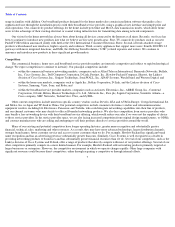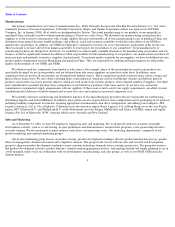Netgear 2010 Annual Report Download - page 18
Download and view the complete annual report
Please find page 18 of the 2010 Netgear annual report below. You can navigate through the pages in the report by either clicking on the pages listed below, or by using the keyword search tool below to find specific information within the annual report.
Table of Contents
If we fail to continue to introduce new products that achieve broad market acceptance on a timely basis, we will not be able to compete
effectively and we will be unable to increase or maintain net revenue and gross margins.
We operate in a highly competitive, quickly changing environment, and our future success depends on our ability to develop and introduce
new products that achieve broad market acceptance. Our future success will depend in large part upon our ability to identify demand trends in
the commercial business, home user, and broadband service provider markets and quickly develop, manufacture and sell products that satisfy
these demands in a cost effective manner. Successfully predicting demand trends is difficult, and it is very difficult to predict the effect
introducing a new product will have on existing product sales. We will also need to respond effectively to new product announcements by our
competitors by quickly introducing competitive products.
We have experienced delays and quality issues in releasing new products in the past, which resulted in lower quarterly net revenue than
expected. In addition, we have experienced, and may in the future experience, product introductions that fall short of our projected rates of
market adoption. Any future delays in product development and introduction or product introductions that do not meet broad market acceptance
could result in:
Throughout 2010, we have significantly increased the rate of our new product introductions. If we cannot sustain the rapid pace of
innovation, we may not be able to maintain or increase the market share of our products. In addition, if we are unable to successfully introduce
new products with higher gross margins, our net revenue and overall gross margin would likely decline.
The average selling prices of our products typically decrease rapidly over the sales cycle of the product, which may negatively affect our
net revenue and gross margins.
Our products typically experience price erosion, a fairly rapid reduction in the average unit selling prices over their respective sales cycles.
In order to sell products that have a falling average unit selling price and maintain margins at the same time, we need to continually reduce
product and manufacturing costs. To manage manufacturing costs, we must collaborate with our third-party manufacturers to engineer the most
cost-effective design for our products. In addition, we must carefully manage the price paid for components used in our products. We must also
successfully manage our freight and inventory costs to reduce overall product costs. We also need to continually introduce new products with
higher sales prices and gross margins in order to maintain our overall gross margins. If we are unable to manage the cost of older products or
successfully introduce new products with higher gross margins, our net revenue and overall gross margin would likely decline.
Changes in tax rates, adverse changes in tax laws or exposure to additional income tax liabilities could affect our future profitability.
Factors that could materially affect our future effective tax rates include but are not limited to:
16
•
loss of or delay in revenue and loss of market share;
•
negative publicity and damage to our reputation and brand;
•
a decline in the average selling price of our products;
•
adverse reactions in our sales channels, such as reduced shelf space, reduced online product visibility, or loss of sales channel; and
•
increased levels of product returns.
•
Changes in the regulatory environment;
•
Changes in accounting and tax standards or practices
•
Changes in the composition of operating income by tax jurisdiction; and
•
Our operating results before taxes.
























